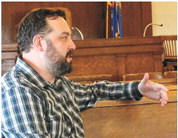A mess


Shaw Report Released
Misunderstandings, missteps, manipulation; remedies highlighted in attorney’s report onVSO
Taylor County was deficient in its handling of interactions with former veterans service officer Shellie Shaw.
That is the finding from a 17-page executive summary prepared by attorney Jacob Curtis of Attolles Law on behalf of the county’s insurance carriers.
In August 2022, the county reached out to its insurance carrier, County Mutual Insurance, to conduct a review of the relationship of the Taylor County Veterans Service Office and the County Board leadership. The Insurance carrier assigned the case to Attolles Law of Milwaukee. Attorney Curtis conducted interviews and reviewed extensive documentation in preparing the report.
A draft version of the report had been presented to county board supervisors during closed session at their October board meeting. On January 5, the final executive summary was released to the public after being revised on January 4. 2023.
The report reviewed the county’s interactions with Shaw from the exchange of emails between Shaw and former Human Resources Director Marie Koerner regarding the office hours during the 2021 holiday season; to the change in the See REPORT on page 5 veterans service committee in March 2022; interaction between committee chairman Lester Lewis and Shaw in March and April; the details of Shaw’s administrative leave from the office in spring 2022; and the exchange of allegations regarding accusations of harassment and even allegations of death threats in early to mid summer, which ultimately led to Shaw’s resignation on August 19.
Attorney Curtis noted that many of the documents he reviewed in his report appeared to focus on “personal conflict and interpersonal relationships, what underlies much of the conflict in fact appears to be a significant misunderstanding of the proper roles and responsibilities of County elected officials, department heads and professional staff.”
Taylor County operates under a county administrative coordinator organizational structure with the bulk of day to day oversight of departments falling to the department heads and to their oversight committees. Historically county committee chairs have taken an active role in working with the department heads.
According to Curtis, the county supervisors should instead be serving primarily a legislative function. “No operational control should reside with individual supervisors. In fact, a supervisor’s authority is collective versus individual,” Curtis stated in the report.
He clarified that the non-elected department heads have the leadership role in their departments “within the policies and procedures set by the board of supervisors and clarified through directives from the coordinator.”
Curtis went on to state that individual county board supervisors have no management or leadership role outside of committees and commissions and cited the 1996 court of appeals case Schuette vs. Van De Hey which differentiates between policy and administration.
Curtis states: “Numerous statements could be referenced to establish the misunderstanding regarding the different roles; however two in particular stand out. In response to the April 8 complaint from the VSO, Lewis indicated to the sheriff ‘he did not feel [making an appointment with the VSO] was acceptable as he is the chairman of her committee and will need to come to her office to discuss issues as needed.’ Contrast this statement with [benefit specialist Nikki] Sherman’s statement that the VSO should be able to ‘run their office as they see fit.’ Both are wrong.”
According to Curtis much of the friction started with compensation time issues in late 2021. He noted that the ability to use accrued personal time is an administrative exercise based on county policy. “The VSO should not have involved a committee in disputing the use of such time,” Curtis stated, noting that human resources would be more than capable of assisting the department head to navigate the use of the personal time and its impact on the office.
Curtis also noted that it was not appropriate for the committee, and falls under the definition of micro-managing for the committee to decide whether a department head may require appointments be requested in advance.
Curtis continued to highlight what he views as deficiencies in the county operations highlighting the county’s committee- heavy organizational model.
“The committee-heavy organizational model combined with aggressive oversight by committee chairmen resulted in significant misunderstandings and the debate of issues that would have more appropriately been had in closed session,” he stated.
Curtis focused on the number of committees that share various oversight responsibilities noting this can result in “a patchwork of responsibilities.”
“In turn, this patchwork can result in conflicting decisions, a lack of direction and/or communication,” Curtis stated.
He gave the example of the December 2021 Veterans Service Committee decision approving personal days when the decision should have been left to human resources. In addition, cited the veterans service committee approving use of the space across the hall for waiting room while the building and grounds committee did not approve the move. “No clear explanation was given for the inconsistent position between the two committees,” he wrote, noting that if one had been given the question would remain why two separate committees would be involved in such an operational question.
Curtis also noted the county could have also utilized additional closed sessions to potentially reduce its risk of liability, citing state law that provides for an exemption to open meeting law requirements in some personnel matters. However he also noted that Shaw contributed in inflaming the interactions by referencing the administrative leave that occurred in April 2022. As noted in the attorney’s report Shaw requested the administrative leave.
“The fact that she initiated the request and human resources was simply following the county’s policy for responding to such requests was not made known to the public and almost certainly contributed to additional difficult questions that the committee was essentially prohibited from answering,” he wrote.
Curtis also addressed the relationship between the VSO and county veterans.
“While not directly related to overall organizational issues, it is worth noting the actions of the VSO, in particular her attempts to organize county veterans in support of her employment (and in some cases in opposition to county board members) certainly contributed to the dysfunction experienced during her tenure,” Curtis stated.
He noted that while the VSO should directly interact with veterans, the attorney raised concern about how that relationship was used to impact county decision making.
“It appears at times Shaw used her relationship with the veterans to essentially defend her or in some cases lobby for specific actions. Any such attempt to ‘utilize’ veterans in this way would almost certainly be considered outside the scope of the statutorily defined responsibilities of a VSO,” Curtis stated.
Curtis noted the numerous people he interviewed in preparing the report, noted Shaw’s attempts to “meet and presumably organize veterans before and after committee meetings.”
“Any effort on the part of a department head to organize the clients served by the county could be considered an inappropriate use of county resources and an abuse of the powers of the respective office,” Curtis wrote.
Recommendations
In the report, attorney Curtis gave recommendations for the county moving forward.
He specifically noted in the report that none of the recommendations suggest the termination of employment of county employees or the removal of county elected officials.
“Such recommendations would be outside the scope of this memorandum,” he stated.
The four recommendations made by Curtis in the report are, as follows: Leadership training for board and department heads. He noted that much of the conflict between the VSO and the county can be attributed to “fundamental misunderstanding” of the proper roles and responsibilities of elected officials and county staff. He said understanding the respective roles could help in resolving current conflict and avoiding future conflict.
Streamlining committee structure. Curtis noted the “patchwork committee structure” has created confusion. “Streamlining committee structures in its simplest form could mean better defining respective areas of oversight and in its most aggressive form could result in the elimination and consolidation of committees to better focus the attention of supervisors. He also stated consideration should be given to limiting the number of committees individual supervisors can serve on.
Transitioning to an administrator form of government. He said such a move could gain organizational efficiencies and streamlined communication while at the same time leaving supervisors to focus on policy making. At the minimum he said the board should take advantage of the administrative coordinator within the organizational structure.
“The board should empower [administrative coordinator Nicole] Hager and give the tools (and authority) necessary to fully carry out her statutorily defined responsibilities,” Curtis wrote.
Update Chapter 6 of county code regarding ethics and records. Curtis noted the county lacks a general ethics code. He stated that updating the code “could generate important discussion and debate regarding the ethical boundaries of both elected officials and staff and the proper process for submitting and reviewing complaints.”
In the report, Curtis stated the county should focus on the areas of deficiency he found and consider implementing one or more of recommendations to “move the county forward in a positive direction.”
— Attorney Jacob Curtis of Attolles Law about the veterans service officer involving veterans in her personnel issues with the county.






